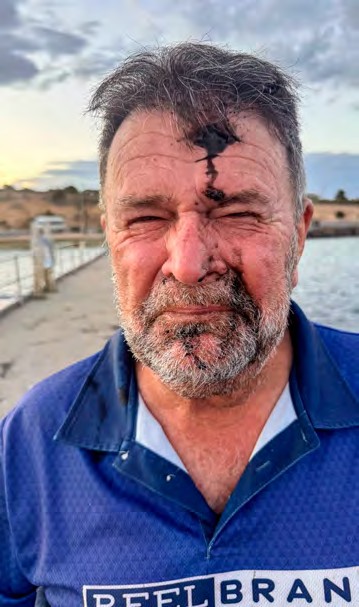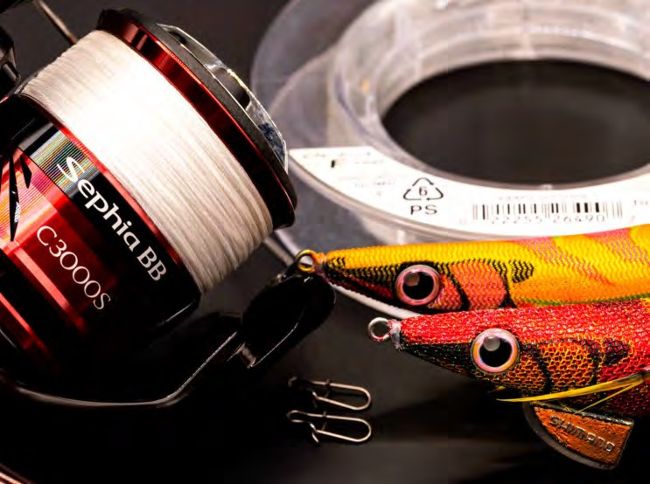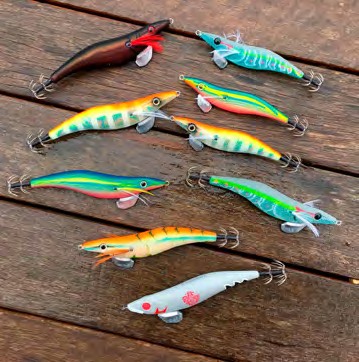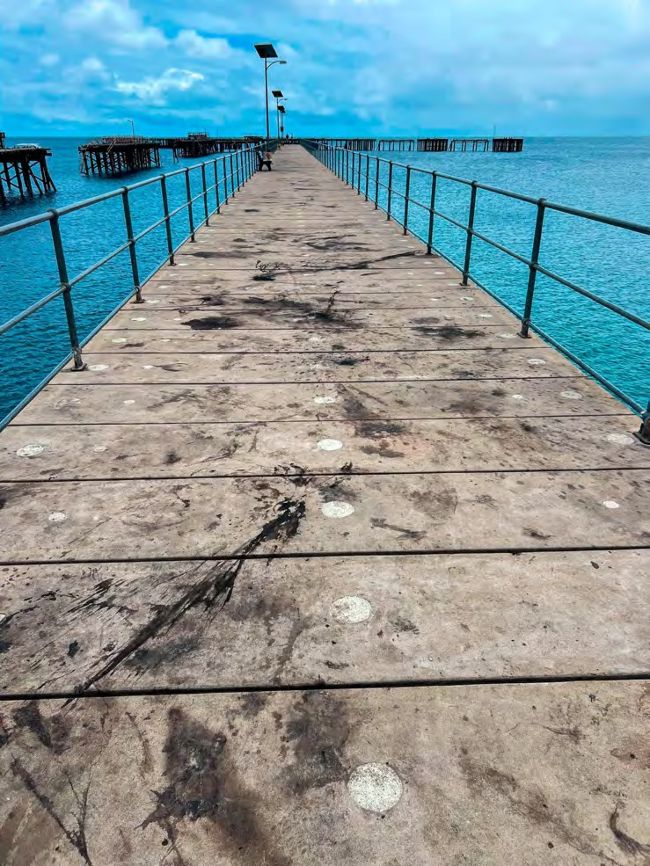THANK HEAVENS FOR SQUID!
Shane Mensforth explains why squid are so important to him – as well as thousands of other South Aussies who enjoy catching and eating some of the best seafood in the world.
Iused to love watching my grandfather, Harry, make stuff in his back shed. He was a clever old bugger who could work with timber, metal, plastic and even masonry to create all manner of useful things. He’d never had training of any description on the tools, but was blessed with one of those inventive minds that was always on the job. He made his own centrepin fishing reels, he made the guides and reel seats for home-built cane rods, and he crafted all manner of lures, sinkers and other terminal tackle. He even created his own range of filleting knives from scratch, one of which I still have today.
I can recall one morning watching him make a very strange looking device that involved twisting wire, soldering various bits and pieces to a central shaft, and somehow attaching some large fish hooks to the bottom. I’d never seen anything like it before, and he refused to tell me what he was up to until his work was completely finished.
As it turned out, Harry’s latest creation was the first squid ‘jag’ I’d ever seen. He worked at GMH with a Greek guy who was always talking about the calamari he was catching and how good it was to eat. Now, I’m certain my grandfather wouldn’t have even considered putting a piece of squid in his mouth (as was the case with most Aussies at that time), but he would definitely have been interested in having some for bait, so he quizzed his friend about how, where and when to catch them. The device Harry had created was a direct copy of the Greek fisherman’s squid ‘jag’, and I was immediately fascinated.

Elijah Ioakim with a lovely Yorke Peninsula calamari
The following weekend, Harry, my father, brother and I toted the usual mountain of gear down Grange jetty for an afternoon/ evening session. The usual plan during the summer months was to target yellowfin whiting in the first gutter for the last hour of the run-in tide, then move out deeper around sunset to try for tommies and gar. Provided conditions were right, rarely did we miss out on a decent feed of all three varieties.
After catching an impressive bag of big, fat yellowfin between us and setting up for tommies out near the shelter shed, Harry broke out his home-made squid ‘jag’ and connected it to a hand spool of heavy line; no surprises at all there, but when he produced a medium-sized potato, peeled it and carved it into a torpedo shape, I knew we were in for something very different. My knowledge of squid and their habits was limited at that stage, but I was pretty sure that spuds weren’t on their usual menu. What in the hell was the old bloke thinking?
I said nothing as he dropped the ‘jag’ over the side and tied the nylon off around the nearest jetty light pole. 20 seconds later he excitedly grabbed the line, which had grown taut and was obviously moving around, and gleefully pulled a sizeable squid up over the handrail and onto the planks. This was the first squid I’d ever seen in the flesh, and to say I was both impressed and excited would be an understatement.
I reckon I would have been nine or ten at that stage, and with my next instalment of pocket money I bought a factory-made wire squid ‘jag’ from Grant’s Tackle shop on Grange Road at Flinders Park. Harry would undoubtedly have made me one if I’d asked, but I liked the idea of procuring things for myself, and the new acquisition immediately took pride of place in my modest tackle collection.
As the saying goes, there have been ‘a lot of fish in the pail’ since that jetty expedition more than half a century ago, but my fascination with southern calamari has never faltered. Like an enormous number of South Aussies, I still adore chasing squid, particularly as I now live on eastern Yorke Peninsula where they are on tap virtually year-round. I’ve never been one for investing in a heap of specialised ‘EGI’ tackle, or amassing a vast collection of squid lures, preferring to use general purpose gear and keep the whole exercise low-tech. Having said that, I can fully understand why some anglers treat the calamari chase like a science project, becoming obsessed with jig sizes, colours and actions, buying a bundle of expensive purpose-designed rods, and even spooling up with so called ‘EGI braid’.
Over the decades I’ve been fortunate enough to catch a heap of exotic fish in dozens of locations around the world, but the enjoyment derived from hooking a pulsing, inking calamari has never taken a back seat. Exactly why I still look forward to catching my next squid as much as my first is hard to put a finger on really, but it’s something I share with thousands of anglers – for a variety of reasons.
We all know how good calamari is on the plate, lending itself to dozens of recipe options and cooking styles. Likewise, we all appreciate how readily accessible squid are to virtually anyone around coastal SA, and we are also aware of how easy they are to catch. A ten-dollar hand spool and a couple of jigs will put you in the game, or you can spend $500 on a high-end outfit that may or may not result in a better catch. You can make squid fishing as basic or as complicated as you like, which is perhaps the most significant factor in its ongoing popularity.

Squid are voracious predators, even at this size!
As I get older and less inclined to revisit the often fanatical times of my fishing youth, chasing squid is growing more popular by the minute. As an alternative to spending hours assembling tackle, preparing the boat and studying tides, moons and weather charts, I’m happy these days to either launch the tinny or amble down to the local jetty with squid rod in hand. This doesn’t mean, of course, that I’ve hung up the blue water gear or sold off the surf rods, but having to think less about my next fishing trip has a certain appeal – and squidding invariably means thinking less!
Like most keen squidders, I like to mix things up by trying jetties and rocks within comfortable drive of home, as well as launching the boat when conditions are right. I have a well-loved 4.3m Stacer tinny, which seems to get a lot more usage than the big Bar Crusher these days.

Yep, that’s the Editor!
These days I keep my squidding gear to two outfits, which I use from the local jetty or out in the boat. Both involve seven foot, 4-6kg rods matched with 4000 size threadlines spooled with 8kg braid. I connect a couple of metres of 8kg mono to the braid and finish off with one of those nifty Mustad Fastach connectors. I use one of these outfits for the usual cast and retrieve squidding technique, and set the other up with a styrene float – a combination that seems to work well, on or offshore. I do own a slightly longer rod of around 3m for rock fishing, which doesn’t see the light of day much now as my enthusiasm for the rocks gradually evaporates.
Neither of these outfits is overly expensive, nor do they require much TLC – which fits nicely into my now infamous (lack of) tackle maintenance regime. The neoprene grips on both rods are ‘pock marked’ with pin pricks from squid jig barbs, which I use to secure the jig when the outfit is in storage or in transit. They are well ‘inked’ from tip to butt and, apart from the occasional hit of fresh water, the reels rarely see any maintenance at all. I’m not advocating tackle negligence here, of course, but rather simply putting it out there that my squid gear lives in a semi-toxic environment and still catches calamari as well as it did when I first bought it.


Undoubtedly, the hottest topic of conversation when talking squid fishing with other anglers is jig colour. Ask a dozen guys about their preferred colour combo and I bet you get at least ten different responses. Similarly, there are different trains of thought on jig sizes; it’s a matter of becoming comfortable with a small selection of squid jigs and fishing them with confidence. Most times out, I will use the same jig from go to whoa, even when someone else in the boat seems to be catching more on one specific pattern. There have been odd occasions when a black jig or a white jig or a green jig has dominated – to the point where there’s simply been no choice but to change over, but these days are rare. I often reckon we give squid too much credit in the IQ department; they are far from the Einsteins of the piscatorial world, and I’m sure we overthink the whole scenario way too often.
When out in the boat, drifting my favourite inshore weed beds and primarily casting jigs, I often rig up a second rod with a jig beneath a styrene float. I chuck this out 30m or so behind the boat and regularly pick up a few stragglers that otherwise may not have ventured within casting range. The floating set-up rarely accounts for more than a quarter of the catch, but it occasionally tops things up when the bite is slow. I like to incorporate a small ball sinker just above the jig to keep it down when you’re drifting, and I usually run the outfit up high in the overhead rod rack to keep it out of the way of those casting around the boat.
It’s always been my preference to direct casts up into the direction of drift, which assists in keeping the jig down and darting across the top of the weed beds. However, I’ve seen this theory shot out of the water regularly in recent times by my eightyear-old grandson, River, who plants himself in the starboard aft corner of the boat and simply drags his jig just under the surface, rarely moving the rod tip. At one stage over the Easter weekend he had me eight squid to one, which was pretty amusing – for him at least! As soon as I started fishing the same way, my tally started to increase, but he still knocked me off overall for the session – something he reminds of me regularly.
As has become the case Australia-wide, calamari is now up there with the most appealing seafood you can catch or buy. It’s one of the driving factors behind my continued love of squid fishing, and the reason why our freezer is always well stocked. Squid is one of very few seafoods that actually improves after freezing, adding to its versatility and universal popularity. If vacuum packed and frozen soon after processing, you can expect up to 12 months in the freezer – something that’s simply not possible with most fish or marine crustaceans.

Rapid Bay jetty is an obvious calamari hot spot
Being a self-confessed seafood junkie and incessantly delving into the wonderful world of seafood cooking, I reckon I’ve done calamari in at least 20 different ways since moving to Yorke Peninsula. At least half of those have been borrowed from renowned chefs like Nigella Lawson, Neil Perry, Poh Ling Yeow, Adam Liaw and particularly Rick Stein, who I consider to be the best of them all. Because I now live in ‘Calamari Central’, I have the opportunity to prepare, cook and serve squid in as many ways as I like, and I can tell you failures have been few and far between. It’s such a forgiving medium to cook with.
So, if you can identify with at least some of what I’ve written here, and agree that we have been blessed with abundance of some of the best seafood on the planet, maybe you can join me in offering thanks to the Fishing Gods. I would hate to even think about a world without southern calamari!